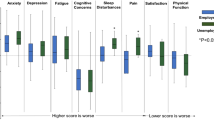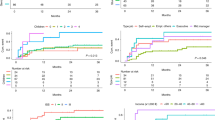Abstract
Introduction
Work return is an indicator of recovery and functional status for cancer survivors. We investigated whether demographic, medical and functional factors predicted full-time work return following hematopoietic cell transplantation (HCT).
Methods
Adults (N = 197), most with hematologic malignancy, completed assessments before their HCT and at intervals over 5 years. Assessments included treatment and demographic factors, and date of return to full-time work. We created binary variables, indicative of major impairment, from the Short Form 36 Health Survey (SF-36) mental (MCS) and physical (PCS) function component scores, dichotomized at 1 SD below population norms (≤40 vs. >40). PCS and MCS were imputed for 16% of the sample. Predictors of work return were analyzed using Cox proportional hazards regression.
Results
Of the 130 patients working full-time at pre-HCT, 88 (68%) were alive and relapse-free at 5 years. Of these, 53 (60%) had returned to full-time and 28 (32%) to part-time work. For the primary analyses at 6 month post-HCT, 14 patients had already died or relapsed and 10 had returned to work. Among the remaining 106 patients, those with PCS >40 returned to work faster (Hazard Ratio (HR) 2.38, 95% Confidence Interval (CI) 1.26–4.49). Female survivors were less likely to return to work than males (HR 0.54, 95% CI 0.29–0.99).
Conclusion
Return to work is a lengthy process for many survivors. Predictors of slower return include physical dysfunction and female gender.
Implications for cancer survivors
Realistic preparation for time off work is essential to long-term health and finances of cancer survivors.





Similar content being viewed by others
References
de Boer AG, Taskila T, Ojajarvi A, van Dijk FJ, Verbeek JH. Cancer survivors and unemployment: a meta-analysis and meta-regression. JAMA. 2009;301(7):753–62.
Bradley CJ, Bednarek HL. Employment patterns of long-term cancer survivors. Psycho-Oncology. 2002;11(3):188–98.
Short PF, Vasey JJ, Tunceli K. Employment pathways in a large cohort of adult cancer survivors. Cancer. 2005;103(6):1292–301.
Spelten ER, Sprangers MA, Verbeek JH. Factors reported to influence the return to work of cancer survivors: a literature review. Psycho-Oncology. 2002;11(2):124–31.
Syrjala KL, Langer SL, Abrams JR, Storer B, Sanders JE, Flowers ME, et al. Recovery and long-term function after hematopoietic cell transplantation for leukemia or lymphoma. JAMA. 2004;291(19):2335–43.
Hensel M, Egerer G, Schneeweiss A, Goldschmidt H, Ho AD. Quality of life and rehabilitation in social and professional life after autologous stem cell transplantation. Ann Oncol. 2002;13(2):209–17.
Lee SJ, Fairclough D, Parsons SK, Soiffer RJ, Fisher DC, Schlossman RL, et al. Recovery after stem-cell transplantation for hematologic diseases. J Clin Oncol. 2001;19(1):242–52.
Duell T, van Lint MT, Ljungman P, Tichelli A, Socie G, Apperley JF, et al. Health and functional status of long-term survivors of bone marrow transplantation. EBMT Working Party on Late Effects and EULEP Study Group on Late Effects. European Group for Blood and Marrow Transplantation. Ann Intern Med. 1997;126(3):184–92.
Deeg HJ, Leisenring W, Storb R, Nims J, Flowers ME, Witherspoon RP, et al. Long-term outcome after marrow transplantation for severe aplastic anemia. Blood. 1998;91(10):3637–45.
Edman L, Larsen J, Hagglund H, Gardulf A. Health-related quality of life, symptom distress and sense of coherence in adult survivors of allogeneic stem-cell transplantation. Eur J Cancer Care (Engl). 2001;10(2):124–30.
Molassiotis A, Boughton BJ, Burgoyne T, van den Akker OB. Comparison of the overall quality of life in 50 long-term survivors of autologous and allogeneic bone marrow transplantation. J Adv Nurs. 1995;22(3):509–16.
Heinonen H, Volin L, Uutela A, Zevon M, Barrick C, Ruutu T. Quality of life and factors related to perceived satisfaction with quality of life after allogeneic bone marrow transplantation. Ann Hematol. 2001;80(3):137–43.
Socie G, Mary JY, Esperou H, Robert DV, Aractingi S, Ribaud P, et al. Health and functional status of adult recipients 1 year after allogeneic haematopoietic stem cell transplantation. Br J Haematol. 2001;113(1):194–201.
Syrjala KL, Langer SL, Abrams JR, Storer BE, Martin PJ. Late effects of hematopoietic cell transplantation among 10-year adult survivors compared with case-matched controls. J Clin Oncol. 2005;23(27):6596–606.
Steiner JF, Cavender TA, Main DS, Bradley CJ. Assessing the impact of cancer on work outcomes: what are the research needs? Cancer. 2004;101(8):1703–11.
Short PF, Vargo MM. Responding to employment concerns of cancer survivors. J Clin Oncol. 2006;24(32):5138–41.
Syrjala KL, Chapko MK, Vitaliano PP, Cummings C, Sullivan KM. Recovery after allogeneic marrow transplantation: prospective study of predictors of long-term physical and psychosocial functioning. Bone Marrow Transplant. 1993;11(4):319–27.
Broers S, Kaptein AA, Le Cessie S, Fibbe W, Hengeveld MW. Psychological functioning and quality of life following bone marrow transplantation: a 3-year follow-up study. J Psychosom Res. 2000;48(1):11–21.
Blume KG, Forman S, Appelbaum FR, editors. Thomas' hematopoietic cell transplantation. 3rd ed. Malden: Blackwell; 2004.
Flowers ME, Lee S, Vogelsang G. An update on how to treat chronic GVHD. Blood. 2003;102(6):2312.
Lee SJ, Vogelsang G, Flowers ME. Chronic graft-versus-host disease. Biol Blood Marrow Transplant. 2003;9(4):215–33.
Vogelsang GB. How I treat chronic graft-versus-host disease. Blood. 2001;97(5):1196–201.
Wingard JR, Curbow B, Baker F, Piantadosi S. Health, functional status, and employment of adult survivors of bone marrow transplantation. Ann Intern Med. 1991;114(2):113–8.
Mosher CE, Redd WH, Rini CM, Burkhalter JE, DuHamel KN. Physical, psychological, and social sequelae following hematopoietic stem cell transplantation: a review of the literature. Psycho-Oncology. 2009;18(2):113–27.
Russell JA, Larratt L, Brown C, Turner AR, Chaudhry A, Booth K, et al. Allogeneic blood stem cell and bone marrow transplantation for acute myelogenous leukemia and myelodysplasia: influence of stem cell source on outcome. Bone Marrow Transplant. 1999;24(11):1177–83.
Lee SJ, Loberiza FR, Rizzo JD, Soiffer RJ, Antin JH, Weeks JC. Optimistic expectations and survival after hematopoietic stem cell transplantation. Biol Blood Marrow Transplant. 2003;9(6):389–96.
Parimon T, Au DH, Martin PJ, Chien JW. A risk score for mortality after allogeneic hematopoietic cell transplantation. Ann Intern Med. 2006;144(6):407–14.
Jager HR, Williams EJ, Savage DG, Rule SA, Hajnal JV, Sikora K, et al. Assessment of brain changes with registered MR before and after bone marrow transplantation for chronic myeloid leukemia. AJNR Am J Neuroradiol. 1996;17(7):1275–82.
Socie G, Clift RA, Blaise D, Devergie A, Ringden O, Martin PJ, et al. Busulfan plus cyclophosphamide compared with total-body irradiation plus cyclophosphamide before marrow transplantation for myeloid leukemia: long-term follow-up of 4 randomized studies. Blood. 2001;98(13):3569–74.
Ware JE Jr, Sherbourne CD. The MOS 36-item short-form health survey (SF-36). I. Conceptual framework and item selection. Med Care. 1992;30(6):473–83.
Ware JE Jr, Kosinski M, Bayliss MS, McHorney CA, Rogers WH, Raczek A. Comparison of methods for the scoring and statistical analysis of SF-36 health profile and summary measures: summary of results from the Medical Outcomes Study. Med Care. 1995;33(4 Suppl):AS264–79.
Ware JE Jr, Kosinski M, Keller SD. SF-36 physical and mental health summary scales: A user's manual. Boston: The Health Institute; 1994.
Rubin DB. Multiple imputation for non-response in surveys. New York: John Wiley and Sons, Inc.; 1987.
van Buuren S, Boshuizen HC, Knook DL. Multiple imputation of missing blood pressure covariates in survival analysis. Stat Med. 1999;18(6):681–94.
Wood AM, White IR, Royston P. How should variable selection be performed with multiply imputed data? Stat Med. 2008;27(17):3227–46.
Pintilie M. Dealing with competing risks: testing covariates and calculating sample size. Stat Med. 2002;21(22):3317–24.
Hosmer DW, Lemeshow S. Applied survival analysis. New York: John Wiley and Sons, Inc.; 1999.
Institute of Medicine. From Cancer Patient to Cancer Survivor: Lost in Transition 2005.
Acknowledgments
Supported by grants from the National Cancer Institute (CA 63030, CA78990, CA112631). We thank Thomas Wickizer for his helpful comments on an earlier draft.
Conflict of interest
We report no conflicts of interest.
Author information
Authors and Affiliations
Corresponding author
Rights and permissions
About this article
Cite this article
Kirchhoff, A.C., Leisenring, W. & Syrjala, K.L. Prospective predictors of return to work in the 5 years after hematopoietic cell transplantation. J Cancer Surviv 4, 33–44 (2010). https://doi.org/10.1007/s11764-009-0105-2
Received:
Accepted:
Published:
Issue Date:
DOI: https://doi.org/10.1007/s11764-009-0105-2




